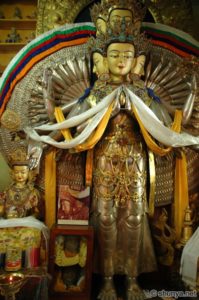The Silver image of Lord Avalokitesvara
King Songtsen Gampo first Avalokitesvara in the 7th Century. Located in one of the northern rooms of the central cathedral in Lhasa (also known as Jokhang or Rasa Trulnang Tsuglag Khang), it has been the object of offering and worship by Tibetan people for more than one thousand three hundred years. Throughout this long progression of time it never faced deterioration, mutation or alteration.Rare and valuable as it is, the self-careated
five-possessor image of Avalokitesvara is exceptionally sacred. In the recent times , the Chinese Communist occupation regime in Tibet conducted a so-called ‘Cultural Revolution,’ which was nothing but acts of vandalism, perversion and xenophobia. It resulted in the most barbarous annihilation of the old culture, including the destruction of icons and cultural objects. In 1966, the cultural and religious objects housed in the central cathedral were subjected to the maniacal fury of destruction. The image of Avalokitesvara was disfigured, removed and thrown to the streets. Unmindful of the risks involved, Tibetan people were able to smuggle out of Tibet one wrathful and one peaceful form of the Avalokitesvara’s facial image, Passing from one Tibetan to another, these facial images reached India, via Nepal, in 1976. after on, in 1968, another wrathful facial image of Avalokitesvara and one face of Amitabha were able to reach India through Nepal under similar circumstances.
It is unfortunate and a pity that we are deprived of seeing the self-evolved image of Avalokitesvara with our bare eyes, which was built by King Songtsen Gampo so many hundreds of years age. However, the newly built image of Avalokitesvara which contains thee original contents of the images brought from Tibet, and which has its originally consecrated formula intact is a good substitute for the original image. The idea of building a new image of Lord Avallokitesvara was conceived primarily with resolute intention as an auspicious amen for the meritorious conditions and the temporal and ultimate welfare of the people of Tibet. This white-silver image of Avalokitesvera built in accordance with the white palmo tradition has eleven faces, a thousand hands and a thousand eyes. It is thirteen feet high from the lotus seat and was built in the year 1970, corresponding to Iron Dog year of Tibetan calendar. The consecrated formulas contained within the body of the images are strictly in accordance with the prescription detailed in the sacred literature. The central image is comprised of the three-faced image of the self-evolved image of Avalokitesvara.
There is no difference between the statue, which was housed in the central cathedral in Lhasa and the new one built in India. Therefore, faithful devotees can pay homage and make offerings to it, for it is one and the same as the image of the previous Avalokitesvara. this silver image of Avalokitesvara is seated facing east towards Tibet. The reason for this is to augur well for the image to be returned to Tibet later on , after its temporary residence in this cathedral.

